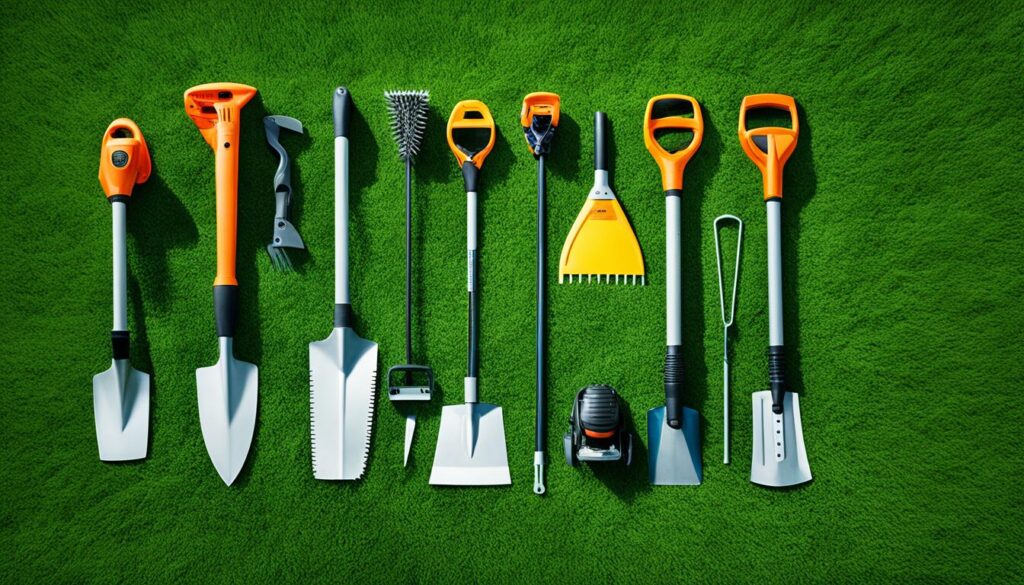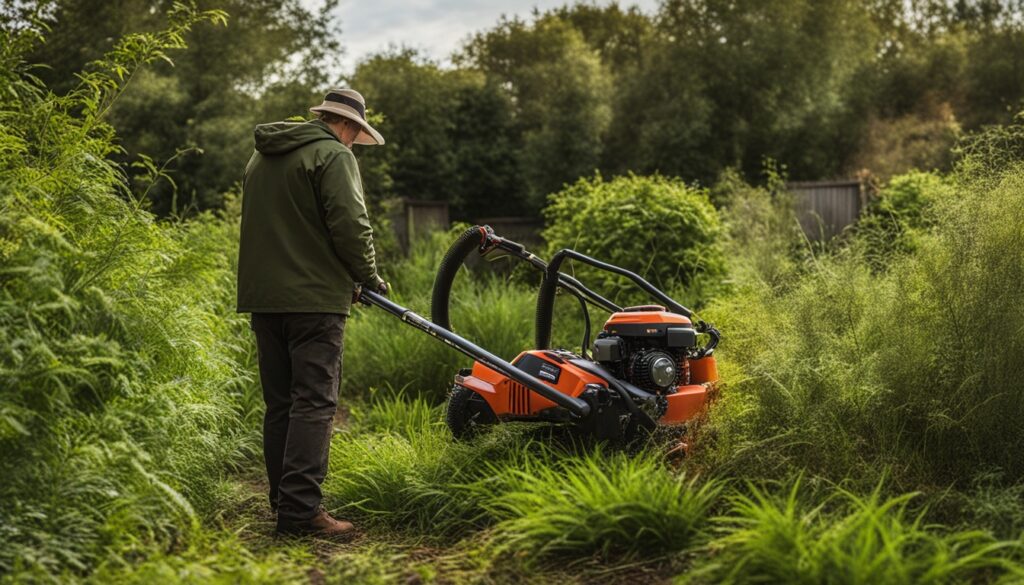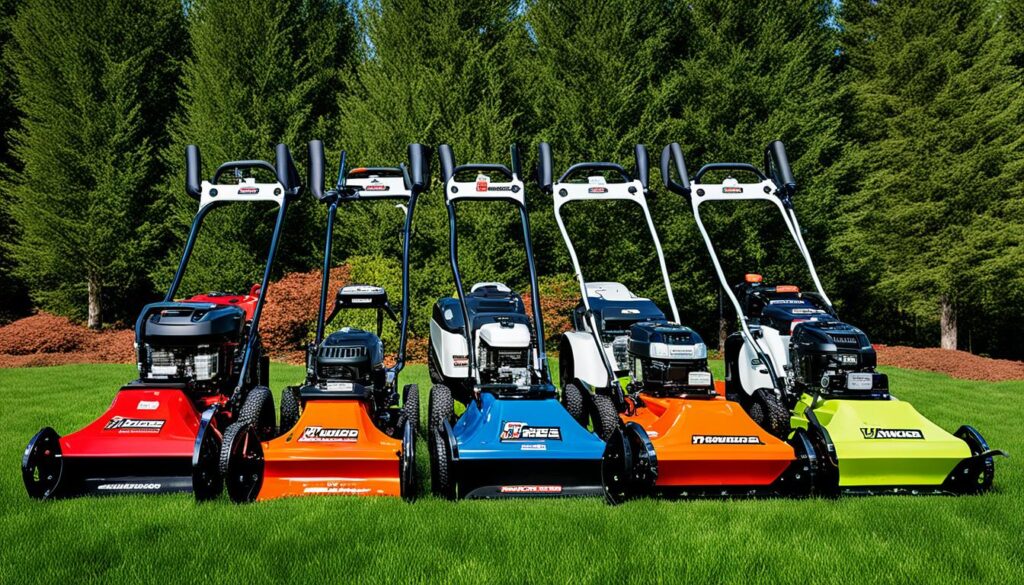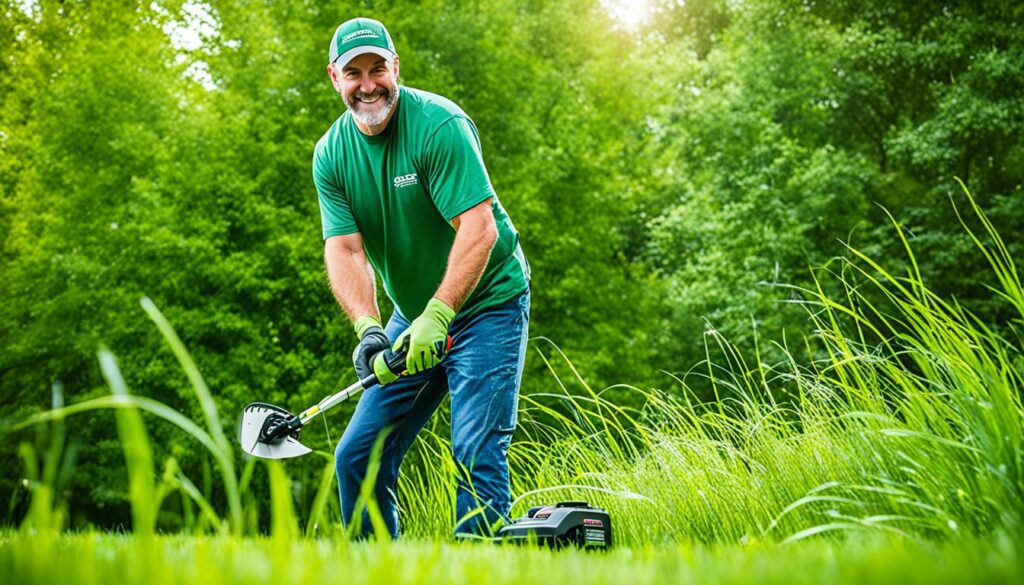Keeping your yard neat or clearing thick plants needs the right tool. For tasks like trimming grass, cutting through thick brush, or clearing big areas, you have three main options. These are the grass trimmer, brushcutter, and clearing saw. Each tool has special features and uses. It’s important to know their differences to pick the best one for you. This guide will look at what makes each tool special. It will help you decide which one fits your needs.
Understanding the Different Types of Yard Tools
When you take care of your outdoor spaces, you have many tools to choose from. You can pick from grass trimmers, brushcutters, and clearing saws. Each tool has its own job and benefits. Let’s look at the main differences between these important gardening tools.
Grass Trimmers
A grass trimmer, also called a string trimmer or weed eater, is a handheld power tool. It cuts grass and weeds in hard-to-reach places. It has a long shaft with a motor and a cutting part at the end. This part uses a spinning string to cut the plants.
Brushcutters
A brushcutter, also known as a brush cutter or clearing saw, is more powerful. It’s made for cutting thick vegetation, brush, and trees. It has a big engine and a heavy-duty cutting part. This lets it handle tough cutting jobs better than grass trimmers.
Clearing Saws
A clearing saw, also called a brush saw, is the most powerful tool for cutting through thick plants and trees. It’s like a brushcutter but even more powerful. It’s great for big land clearing jobs, cutting through small trees and saplings.
Knowing what each yard tool does will help you pick the right one for your garden. This way, you’ll get the best results for your gardening tasks.

Factors to Consider When Selecting a Brushcutter
Choosing the right brushcutter for your yard is important. Think about your lawn’s size and the terrain you’ll face. For small, flat lawns, a lightweight brushcutter might be enough. But for big yards with rough ground, you’ll need something stronger and easier to move.
Lawn Size and Terrain
The size of your lawn and the terrain matter a lot. For small, flat lawns, a light brushcutter works well. But for big yards with tough terrain, you need a powerful brushcutter that can handle it.
Power Source
Think about the brushcutter’s power source too. You can pick between gas or battery models. Gas ones have more power and can move easily but need upkeep. Battery ones are cord-free, great for small yards and light work.
Cutting Mechanism
The way the brushcutter cuts is key too. You can choose between string or blade trimmers. String trimmers are good for light plants. Blade trimmers are best for thick, tough plants.

Think about lawn size, terrain, power source, and cutting mechanism to find the best brushcutter. This way, you can easily and efficiently take care of your yard.
Comparison of Different Brushcutter Types and Features
Choosing between a gas-powered brushcutter and a battery-powered brushcutter can change how you work in your yard. Let’s look at the main features and benefits of these two types.
Gas-powered brushcutters are known for their mobility and power. They have strong, 2-cycle engines from Japan. These tools are great for hard work and big yards. But, they need regular care like mixing fuel and checking spark plugs to work well.
Battery-powered brushcutters are easy to use without cords. They run on rechargeable batteries, perfect for small yards and easy tasks. ECHO makes many battery-powered brushcutters for both home and hard work.
| Feature | Gas-Powered Brushcutters | Battery-Powered Brushcutters |
|---|---|---|
| Power Source | 2-cycle engine | Rechargeable battery |
| Mobility | Excellent | Cord-free |
| Suitable Applications | Professional jobs, large properties | Smaller yards, light-duty tasks |
| Maintenance | Fuel mixing, spark plug checks | Battery charging |
Knowing the special traits of gas-powered and battery-powered brushcutters helps you pick the right tool for your yard and what you like.

Applications and Advantages of Gas-Powered Brushcutters
Gas-powered brushcutters are great for yard work and managing large areas. They have lots of mobility and power. This makes them perfect for professionals and big properties.
These tools have a strong, 2-cycle engine. This engine gives the power to cut through thick plants and trees. They are great for clearing tough areas in homes, businesses, or big rural lands.
Excellent Mobility and Power
Gas-powered brushcutters are more mobile than electric or battery ones. They don’t have to worry about cords or running out of battery. So, they can easily cover big areas, reaching places that are hard to get to.
Suitable for Professional Jobs and Large Properties
For professionals like landscapers and those who take care of big places, gas-powered brushcutters are the best choice. They can handle thick plants and reach far, making them key for many outdoor jobs.

Using a gas-powered brushcutter can make big jobs easier and quicker. It’s great for keeping up a big estate, clearing woods, or getting a site ready for building.
Battery-Powered Brushcutters: Convenience and Versatility
Homeowners looking for an easy yard care solution might want to consider battery-powered brushcutters. They are a great choice compared to gas-powered ones. These tools don’t need cords, giving you more freedom and ease while you work.
Cord-free Operation
Battery-powered brushcutters run on rechargeable batteries. This means you can move around your yard without being tied down by a cord. You can easily reach hard spots and get around obstacles, making yard work better and more fun.
Ideal for Smaller Yards and Light-Duty Tasks
These brushcutters are perfect for small yards or light tasks like trimming grass and weeding. They are small and light, making them easy to use. You can take care of your yard with less effort.
ECHO makes a variety of battery-powered brushcutters that are great for yard work. They offer the power and ease you want without the trouble of gas tools.
| Feature | Makita XRU16PT Battery-Powered Brushcutter |
|---|---|
| Power Source | Two 18V 5-amp-hour rechargeable batteries |
| Cutting Width | 9 inches |
| Weight | 15 pounds |
| Runtime per Charge | 30 minutes |
| Cutting Head Speed | 4,600; 5,500; and 7,000 rpm |
| Price | $699 |
The Makita XRU16PT is a great example of what battery-powered brushcutters can do. It has a strong brushless motor, adjustable speeds, and a harness for comfort. It’s perfect for small yards and light tasks.

Brushcutter Models for Home, Farm, and Professional Use
Choosing the right brushcutter is key for yard upkeep. ECHO makes outdoor power tools for everyone. They have many brushcutter models for homeowners, farmers, and pros.
Homeowners should look at the ECHO SRM-222ES/L gas model and the DSRM-310 ECHO Garden+ 40V battery model. They are great for lawn and garden work. You can cut back overgrown areas easily.
For farmers and pros, the ECHO SRM-2621TES/L gas model and the DSRM-2600/L ECHO 56 eFORCE 56V battery model are perfect. They can handle tough jobs. They’re great for big properties and work.
- ECHO SRM-222ES/L gas-powered brushcutter: Ideal for home use with a 35.8cc engine, 22.0 fl oz fuel tank, and a dry weight of 15.4 lb (without head) or 16.1 lb (with head).
- DSRM-310 ECHO Garden+ 40V battery-powered brushcutter: A convenient cordless option for smaller yards, with a cutting width of 17″ and residential/commercial warranties of 2 years and 1 year, respectively.
- ECHO SRM-2621TES/L gas-powered brushcutter: Designed for farm and professional use, with a main pipe diameter of 1.0 in, a gear ratio of 1.235, and a cutting width of 17″.
- DSRM-2600/L ECHO 56 eFORCE 56V battery-powered brushcutter: A powerful cordless option for professional-grade tasks, offering the convenience of battery-powered operation.
ECHO has a brushcutter for everyone, whether you’re at home, on a farm, or a pro landscaper. They make it easy to keep your yard looking great.
Tips for Maintaining and Using Brushcutters Effectively
To keep your brushcutter running well, follow these steps. Clean it often, check and swap out cutting parts when needed, and use the right oil and fuel mix for gas models.
Regular Maintenance
Always clean your brushcutter’s housing and guard right after you use it. This stops dirt from sticking and helps the tool work better. Keeping the blades sharp cuts down on engine strain and saves fuel, making cuts cleaner and more efficient.
Don’t forget to clean the air filter often to keep the airflow strong. This stops the brushcutter from working poorly. Also, oil the parts that move a lot to stop wear and keep it running smoothly.
Safety Precautions
Always put safety first with a brushcutter. Wear goggles, gloves, and ear protection to stay safe. Know how to use the controls and keep your work area clear to avoid accidents.
Proper Technique
Using a brushcutter right can really improve your work and the tool’s life. Keep a steady pace and angle, and adjust the height as you go. Doing regular maintenance and using it correctly makes your brushcutter work better and last longer.
For more tips on keeping brushcutters safe and in good shape, check out STIHL’s website.
Clearing Overgrown Land: The Power of Brushcutters
Clearing overgrown land can seem hard, but the right tool makes it easy. Brushcutters are great for cutting through dense plants, tall grass, and thick brush. They’re perfect for places where lawnmowers or regular trimmers can’t go.
Brushcutters are powerful and can cut through tough plants. They’re great for clearing fields, lots, and areas with lots of growth. People use them in landscaping, keeping properties in shape, and for farming and forestry.
Using a brushcutter is versatile. You can pick from handheld or big, self-moving machines. These tools are perfect for tough areas, making them a must-have for anyone who works with land.
Brushcutters are the best for controlling plants. They clear areas fast that would take a long time with manual tools. They’re great for keeping up a rural property, getting a site ready for building, or managing a big landscape.
Buying a good brushcutter saves you time and effort. These machines are strong and have safety features like anti-vibration tech and harnesses. With the right brushcutter, you can easily clear tough areas. This makes it easier for your next project.
Brushcutters vs. Grass Trimmers: Understanding the Differences
Choosing between a brushcutter and a grass trimmer is a big decision for yard care. Both tools are used for cutting plants, but they are different. Knowing their unique features can help you pick the right one for your lawn.
Grass trimmers, also known as string trimmers or weed eaters, are great for cutting grass and light plants in hard-to-reach spots. They’re perfect for small to medium lawns, edging, and trimming around obstacles. These tools use a rotating nylon cord to cut through soft plants.
Brushcutters are more powerful and made for thick vegetation, brush, and small trees. They’re great for clearing overgrown areas and controlling weeds. Brushcutters have sharp blades that can cut through tough plants like saplings.
When choosing between a brushcutter vs. grass trimmer, think about your yard’s size and the plants you need to cut. For big yards with lots of overgrowth, a brushcutter is best. It’s also good for vegetation trimming and lawn maintenance. A grass trimmer is better for small yards and light tasks, like keeping your lawn neat.
| Feature | Brushcutter | Grass Trimmer |
|---|---|---|
| Blade Type | Sharp metal blade | Rotating nylon cord |
| Cutting Power | High, suitable for dense vegetation | Low, suitable for light grass and weeds |
| Application | Clearing overgrown areas, controlling invasive weeds, preparing land | Maintaining small to medium-sized lawns, edging, trimming around obstacles |
| Power Source | Gas-powered or electric | Gas-powered or electric |
Understanding the strengths and limits of brushcutters vs. grass trimmers helps you choose the best tool for your lawn maintenance needs. This ensures you manage your outdoor plants well and efficiently.
Clearing Saws: The Ultimate Tool for Heavy-Duty Vegetation Clearing
Brushcutters are great for cutting back vegetation, but for tough jobs, there’s a better choice. The clearing saw, also called a brush saw, is made for heavy-duty vegetation clearing and land management. It’s used in forestry, farming, and other professional areas.
These tools have big, strong cutting parts like circular saw blades or metal brush blades. They can cut through thick and hard vegetation, even small trees and saplings. Clearing saws are perfect for clearing dense, overgrown areas. They make it easy to get land ready for different uses when a brushcutter isn’t enough.
| Feature | Brushcutter | Clearing Saw |
|---|---|---|
| Cutting Mechanism | Trimmer line or plastic/metal blades | Circular saw blade or metal brush blades |
| Cutting Capacity | Smaller vegetation, weeds, and light brush | Thicker vegetation, small trees, and dense brush |
| Application | Lawn and light-duty clearing | Heavy-duty land clearing and management |
| Power | Moderate | High |
Clearing saws are the top choice for tough vegetation clearing jobs. They are a must-have for professionals in forestry, farming, and land management.
Selecting the Right Tool: Brushcutter or Clearing Saw?
Choosing between a brushcutter and a clearing saw depends on your project’s needs. Brushcutters are great for trimming grass, cutting weeds, and even dense brush. They’re perfect for homeowners, landscapers, and those with medium-sized properties.
For big jobs like clearing thick undergrowth or small trees, a clearing saw is better. These saws can handle tough vegetation. They’re ideal for heavy-duty land management and clearing.
Think about your project’s size and the vegetation you’ll face. Decide if you need a brushcutter or a clearing saw. The right tool makes your job easier and gets you the results you want.



